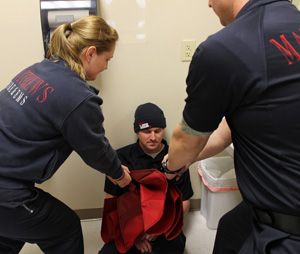One of the benefits of teaching more than 500 classes per year is I get to see a lot of patterns in EMS and fire-rescue; patterns of how responders move, lift, pull, carry, transfer and simply walk. I also get to hear a lot of stories about how responders got hurt and how very few ever get back to normal after an injury.
My aha moment one day was simply this: “EMS is in the moving business; we are movers!”
EMS is in the moving business
Every aspect of our job is physical, all of our tools are heavy and moving people is a critical job task. Yet as a profession we spend little to no time training how to move things safely.
A question I ask in all my classes is “When was the last time you had a detailed patient and equipment handling class?” What I get back are blank stares and finally a few folks grumbling, ‘never.’ We spend most if not all of our training time on clinical excellence and operations and never spend time training to do the most critical job task, moving patients.
Since we are medical movers, departments need to do a much better job teaching providers why they get hurt and how to prevent it. The first thing we need to examine is what the loads we lift do to our body.
How much weight is safe to lift?
NIOSH has a lift equation and while complicated, it tells us one thing: The weight limit for an individual to pick up off the floor is 51 pounds. Picking an object off the floor of that weight will put around 764 to 800 pounds of compressive load on the spine. If that seems like a lot, it is. We know that at around 800 pounds, the spine of an untrained individual (someone who does not work out, is dehydrated, fatigued, or eats poorly) will begin to be injured. When was the last time you picked a 51-pound patient off the floor? Many providers carry a compressive load of over 2,000 pounds every day; multiple times per shift [1-3].
FEMA states in their emergency medical services handbook that EMS should limit lifts below the knees. These lifts generate some of the highest spinal loads we see in providers. If we step out of the EMS box for a second we can look at other ‘moving’ professions and make the connection that we are one of the only professions that allow its employees to regularly lift extreme loads from below the knees on a frequent basis. So when what we perceive to be small loads actually exceed what our body can handle, it leads to providers becoming very skilled at the dangerous movement of lifting from below the knees [4].
Let’s take it a step further and look at lateral transfers. Pulling a 105-pound patient via bedsheet between two beds applies between 832 to 1,708 pounds of compressive force, while carrying the same patient down a set of stairs compresses the spine with 1,012 to 1,281 pounds. [1,2] Again we regularly exceed the ability of the human body to dissipate or dampen the external loads placed upon it.
4 tips for safer patient lifting
Here are four tips for safer lifting and moving of EMS patients.
 |
| Most EMS systems already have the tools on the ambulances that can change the lift height. (Image/courtesy Bryan Fass) |
1. Stop lifting from the floor
As we teach all our students, “use a tool, do not become the tool.” Most systems already have the tools on the trucks that can change the lift height. Use your MegaMover, Reeves or Titan to change the lift height from the floor to almost knee height, where we are much stronger and have a better spine angle.
2. Use handles for lateral transfers
If you follow step one above, then the friction reducing device is already under the patient. Simply slide them over to the hospital bed using a tool that already reduces friction and has handles. The handles mean that on the pull, responders do not have to lean over so far to begin the transfer.
3. Work together to safely lift patients
If and when there are trained personnel on scene, everyone is on the lift. As a culture, EMS and fire-rescue need to understand that if 51 pounds can hurt one person, then it only makes sense that a 350-pound patient requires all hands working together. This goes for your powered cots as well; position two people on the foot of the cot for loading into the truck.
4. Slow down, ensure safety
One of my favorite sayings in EMS is “it’s not my emergency.” Simply slowing down will allow you and your partner andcrew to get in better lifting positions, use tools properly and think ahead to ensure that the lift or move is safe for both you and the patient.
“Your fitness will save your life one day … and every day” is my motto for all of public safety. This is a 100% physical job and one of the only things that will save your life on scene and in life is your physical ability.
References
1. A structural equation modelling approach to predicting adoption of a patient-handling intervention developed for EMS providers.Ergonomics 2013 24;56(11):1698-707. Epub 2013 Sep 24. Monica R Weiler, Steven A Lavender, J Mac Crawford, Paul A Reichelt, Karen M Conrad, Michael W Browne
2. Oregon OSHA. Firefighter and Emergency Medical Services Ergonomics Curriculum, www.cbs.state.or.us/osha/grants/ff_ergo/index.html.
3. McGill, S. Low Back Disaorders. 2007, Human Kinetics. P. 218-222.
4. FIRE AND EMERGENCY MEDICAL SERVICES ERGONOMICS, A Guide for Understanding and Implementing, An Ergonomics Program in Your Department U. S. Fire Administration, Federal Emergency Management Agency 16825 South Seton Avenue, Emmitsburg, MD 21727
This article was originally posted Apr. 10, 2014. It has been updated.













